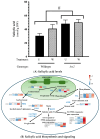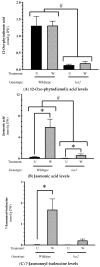Arabidopsis Transcriptomics Reveals the Role of Lipoxygenase2 (AtLOX2) in Wound-Induced Responses
- PMID: 38892085
- PMCID: PMC11173247
- DOI: 10.3390/ijms25115898
Arabidopsis Transcriptomics Reveals the Role of Lipoxygenase2 (AtLOX2) in Wound-Induced Responses
Abstract
In wounded Arabidopsis thaliana leaves, four 13S-lipoxygenases (AtLOX2, AtLOX3, AtLOX4, AtLOX6) act in a hierarchical manner to contribute to the jasmonate burst. This leads to defense responses with LOX2 playing an important role in plant resistance against caterpillar herb-ivory. In this study, we sought to characterize the impact of AtLOX2 on wound-induced phytohormonal and transcriptional responses to foliar mechanical damage using wildtype (WT) and lox2 mutant plants. Compared with WT, the lox2 mutant had higher constitutive levels of the phytohormone salicylic acid (SA) and enhanced expression of SA-responsive genes. This suggests that AtLOX2 may be involved in the biosynthesis of jasmonates that are involved in the antagonism of SA biosynthesis. As expected, the jasmonate burst in response to wounding was dampened in lox2 plants. Generally, 1 h after wounding, genes linked to jasmonate biosynthesis, jasmonate signaling attenuation and abscisic acid-responsive genes, which are primarily involved in wound sealing and healing, were differentially regulated between WT and lox2 mutants. Twelve h after wounding, WT plants showed stronger expression of genes associated with plant protection against insect herbivory. This study highlights the dynamic nature of jasmonate-responsive gene expression and the contribution of AtLOX2 to this pathway and plant resistance against insects.
Keywords: 13S-lipoxygenase; AtLOX2; jasmonate; transcriptome; wounding.
Conflict of interest statement
The authors declare that this research was conducted in the absence of any commercial or financial relationships that could be construed as a potential conflict of interest.
Figures












Similar articles
-
Four 13-lipoxygenases contribute to rapid jasmonate synthesis in wounded Arabidopsis thaliana leaves: a role for lipoxygenase 6 in responses to long-distance wound signals.New Phytol. 2013 Jan;197(2):566-575. doi: 10.1111/nph.12029. Epub 2012 Nov 21. New Phytol. 2013. PMID: 23171345
-
Velocity estimates for signal propagation leading to systemic jasmonic acid accumulation in wounded Arabidopsis.J Biol Chem. 2009 Dec 11;284(50):34506-13. doi: 10.1074/jbc.M109.061432. Epub 2009 Oct 21. J Biol Chem. 2009. PMID: 19846562 Free PMC article.
-
Axial and Radial Oxylipin Transport.Plant Physiol. 2015 Nov;169(3):2244-54. doi: 10.1104/pp.15.01104. Epub 2015 Sep 3. Plant Physiol. 2015. PMID: 26338953 Free PMC article.
-
The squeeze cell hypothesis for the activation of jasmonate synthesis in response to wounding.New Phytol. 2014 Oct;204(2):282-8. doi: 10.1111/nph.12897. New Phytol. 2014. PMID: 25453132 Review.
-
Jasmonate action in plant defense against insects.J Exp Bot. 2019 Jul 5;70(13):3391-3400. doi: 10.1093/jxb/erz174. J Exp Bot. 2019. PMID: 30976791 Review.
Cited by
-
Post-Translational Modifications to Cysteine Residues in Plant Proteins and Their Impact on the Regulation of Metabolism and Signal Transduction.Int J Mol Sci. 2024 Sep 12;25(18):9845. doi: 10.3390/ijms25189845. Int J Mol Sci. 2024. PMID: 39337338 Free PMC article. Review.
-
Impact of Lepidopteran Oral Secretions on the Transcriptome of Arabidopsis thaliana.Plant Direct. 2025 Jun 19;9(6):e70085. doi: 10.1002/pld3.70085. eCollection 2025 Jun. Plant Direct. 2025. PMID: 40546745 Free PMC article.
References
MeSH terms
Substances
Grants and funding
LinkOut - more resources
Full Text Sources
Research Materials

